Egyptian - Recent acquisitions - Sold antiquities
Archive of sold antiquities
All artefacts sold in our gallery are fully documented in our online archive and database. Being a specialist ancient art dealer, preserving also the more recent history of each and every piece sold in our shop is at our heart. That is particularly useful for artefacts that changed owners in the meantime. Information that may have been lost in the process can be easily restored from our archives. Please do not hesitate to contact us if you need further information about ancient items that have been sold in our gallery. We can help you with reconstructing the history of ownership for those items. All information about our customers will be kept confidential, of course.-
 Scarab with inscription
Scarab with inscriptionThe lower side bears a hieroglyph inscription. Nice piece from the Freemark collection. New Kingdom.
Price: on request Ramesside Scarab
Ramesside ScarabEgyptian scarab from the 19th to 20th dynasty. With horse and hieroglyphs.
Price: on request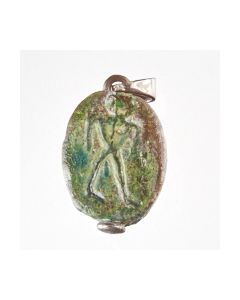 Scarab with standing figure
Scarab with standing figureThe scarab amulet dates to the Late Period. The lower side shows a stading figure, possibly the goddess Neith.
Price: on request Egyptian sarcophagus mask
Egyptian sarcophagus maskImpressive wood relief of an idealized face. Polychrome paint. The mask was part of a sarcophagus lid from the Late Period of Ancient Egypt.
Price: on request Egyptian fingerring from the Amarna period
Egyptian fingerring from the Amarna periodMade of colourful turquoise fayence. Two fully modelled crocodiles adorn the plate. Perfect preservation including original black paint.
Price: on request Egyptian amulet of Anubis
Egyptian amulet of AnubisThe amulet from the Late Period of Ancient Egypt was supposed to protect the dead on their way to the afterlife. From a British private museum.
Price: on request Scarab with scarab motive
Scarab with scarab motiveThe stamp side shows a scarab with two uraeus snakes. This scarab is described in the catalogue of Irène Gautier-Vodoz.
Price: on request Scarab with lotus motive
Scarab with lotus motiveAncient Egyptian amulet seal with beautiful motive. Six lotus flowers are forming volutes. This scarab is described in the catalogue of Irène Gautier-Vodoz.
Price: on request Egyptian amulet of a hare
Egyptian amulet of a hareThis type of amulet was popular in the Late Dynastic Period of Ancient Egypt. It should endow its wearer with fertility and rapidity of movement. The piece was exhibited in an early 20th century private museum.
Price: on request Egyptian amulet of a falcon
Egyptian amulet of a falconThe falcon in Egyptian art can be a depiction of the god Horus or symbolize the soul of the pharao. Falcon amulets are known from the earliest times in Egyptian history. However this speicmen dates to the Late Dynastic Period of Ancient Egypt.
Price: on request Egyptian amulet of Shu
Egyptian amulet of ShuGod of the air and the sun. The highly stylized figurine shows the ancient Egyptian god on his knees, the arms raised towards the sun. From a British private museum.
Price: on request Egyptian pataikos
Egyptian pataikosGod or god-like dwarf. The figurine was supposed to have a magical protective function. 26th to 30th dynasty of Ancient Egypt. From a British private museum.
Price: on request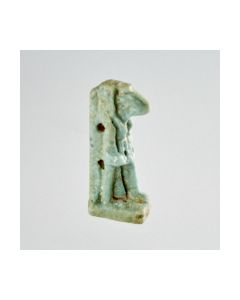 Egyptian amulet of Thoth
Egyptian amulet of ThothIbis headed god of knowledge and writing. 26th to 30th dynasty of Ancient Egypt. From a British private museum.
Price: on request Egyptian amulet of Taweret
Egyptian amulet of TaweretIt shows the goddess of childbirth in the form of a pregnant hippopotamus. The amulet from the Late Period of Ancient Egypt should exert a protective function. From a British private museum.
Price: on request Egyptian amulet of Anubis
Egyptian amulet of AnubisThe amulet from the Late Period of Ancient Egypt was supposed to protect the dead on their way to the afterlife. From a British private museum.
Price: on request Egyptian faience ring showing Bes and Taweret
Egyptian faience ring showing Bes and TaweretThe finger ring with its scene on the plate must have served a protective function for an expectant mother. New Kingdom, approx. 1550 to 1070 BC.
Price: on request Egyptian scarab with papyrus plants
Egyptian scarab with papyrus plantsScarab amulet made of bright, almost white steatite. 13th to 15th dynasty. This scarab is described in the catalogue of Irène Gautier-Vodoz.
Price: on request Scarab with sphinx
Scarab with sphinxThe stamp depicts a sphinx with pharaoh headcloth walking towards the Ankh symbol of life. The amulet should exert a protective function on the one carrying or owning it.
Price: on request Scarab with two cartouches of Thutmose III.
Scarab with two cartouches of Thutmose III.Interesting amulet from the New Kingdom or a later period made in archaic style. This scarab is described in the catalogue of Irène Gautier-Vodoz.
Price: on request Stone statue of a seated Isis
Stone statue of a seated IsisVery fine condition, from an important London collection
Price: on request Egyptian heart scarab
Egyptian heart scarabBig beetle stone from the Late Period of Ancient Egypt. Scarabs of this kind have been placed next to the heart on mummies. Nice mint green fayence.
Price: on request Applique of the Horus son Duamutef
Applique of the Horus son DuamutefBright turquise fayence. Duamutef is one of the four sons of Horus, well-known from the Canopic jars. He had an important protective function for the dead. Egypt, 8th to 4th cent. BC.
Price: on request Skarabäus mit Kartusche des Chaneferre
Skarabäus mit Kartusche des ChaneferreSkarabäus mit Namens-Kartusche des Königs Chaneferre (Sobekhotep IV.). 13. Dynastie des Alten Ägyptens, ca. 1700-1680 v. Chr.
Price: on request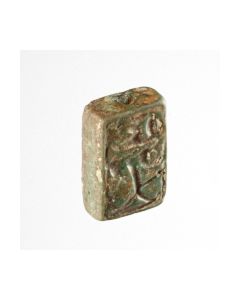 Ägyptisches Plättchen mit Kartusche des Sethos I.
Ägyptisches Plättchen mit Kartusche des Sethos I.Doppelseitige Platte aus grüner Fayence aus dem Neuen Reich, ramessidisch, um 1290 v. Chr. Sphinx und Kartusche (Men-Maat-Re) und Namens-Kartusche mit dem Eigennamen Meri-en-Ptah.
Price: on request Egyptian New Year flask with ornamentation
Egyptian New Year flask with ornamentationHieroglyphic inscription expressing New Year wishes for Ptah at the beginning of the nile floodings. Important 26th dynasty piece associated with the Egyptian New Year rituals. The object is a fantastic example of the skilled workmanship and artistic quality of faience in ancient Egypt.
Price: on request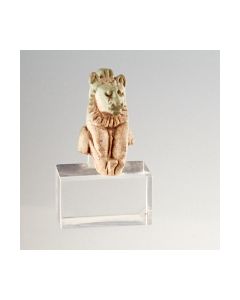 Egyptian amulet of a lion headed goddess
Egyptian amulet of a lion headed goddessAttributed to Sekhmet, goddess of war and protection from illness. Very nice and detailed fayence work. Dating to the Third Intermediate Period to Late Period of Ancient Egypt.
Price: on request Große ägyptische Bronzefigur der Sachmet
Große ägyptische Bronzefigur der SachmetEine wundervoll dunkel-patinierte Bronze der “Göttin des Zitterns ”, Sachmet, in beeindruckender Erhaltung. Vollständig erhalten mit erkennbaren feinen Details.
Price: on request Ägyptischer Skarabäus mit Knotenmuster
Ägyptischer Skarabäus mit Knotenmuster12. bis 18. Dynastie des Alten Ägypten, ca. 2000 v. Chr. bis 1300 v. Chr. Die Stempelfläche trägt ein Knotenmuster mit ästhetischer oder mutmaßlich magischer Funktion.
Price: on request Uschebti aus bemaltem Ton
Uschebti aus bemaltem TonCa. 1200 - 1070 v. Chr., Neues Reich des Alten Ägypten. Vollständig intakt, nicht restauriert. Originale Bemalung weitgehend erhalten.
Price: on request Ägyptischer Uschepti mit rückseitigen Hieroglyphen
Ägyptischer Uschepti mit rückseitigen HieroglyphenÄgyptische Totenfigur. Rückseitige Hieroglyphen. Mintgrüne Fayence. Spätzeit bis Beginn ptolemäische Zeit, 664 v. Chr. - 300 v. Chr.
Price: on request Ägyptischer Uschebti des Pasinebu
Ägyptischer Uschebti des PasinebuTotenfigur für Pasinebu, geboren der Setjet, mit T-förmiger hieroglyphischer Inschrift. 26. bis 30. Dynastie, Spätzeit des Alten Ägyptens. Perfekte Erhaltung mit klar erkennbaren Hieroglyphen.
Price: on request Ägyptischer Uschebti mit rückseitigen Hieroglyphen
Ägyptischer Uschebti mit rückseitigen HieroglyphenÄgyptische Totenfigur. Rückseitige Hieroglyphen. Mintgrüne Fayence. Spätzeit bis Beginn ptolemäische Zeit, 664 v. Chr. bis 300 v. Chr.
Price: on request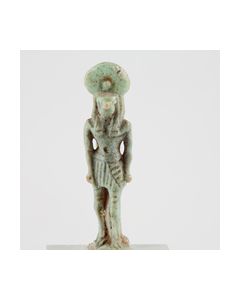 Ägyptisches Amulett des Sonnengottes Ra
Ägyptisches Amulett des Sonnengottes RaMännlichem Körper mit Lendenschurz, darauf Falkenkopf mit Sonnenscheibe. Spätzeit des Alten Ägyptens. Aus der Sammlung des Ägyptologen Dr. Müller-Feldmann.
Price: on request Ägyptisches Amulett der Isis
Ägyptisches Amulett der IsisAmulett aus Fayence mit Darstellung der Isis. Die Göttin trägt ein Gewand und eine dreigeteilte Perrücke, auf dem Kopf den Thronsitz. Spätzeit des Alten Ägyptens.
Price: on request Ägyptisches Papyrusamulett
Ägyptisches PapyrusamulettPapyrusamulett aus mintgrüner Fayence, symbolisch für Jugend und Gedeien. Spätzeit des Alten Ägyptens, 664 bis 332 v. Chr.
Price: on request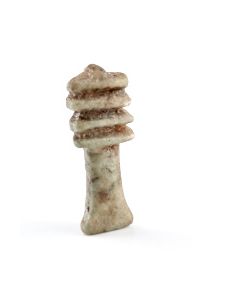 Djed-Pfeiler als Amulett
Djed-Pfeiler als AmulettÄgyptische Spätzeit, 26. bis 30. Dynastie. Mintgrüne Fayence. Der Djed-Pfeiler steht für Dauer und Beständigkeit und war im Alten Ägypten als Amulett sehr beliebt.
Price: on request

